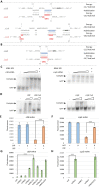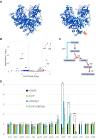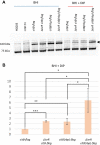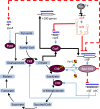Staphylococcal aconitase expression during iron deficiency is controlled by an sRNA-driven feedforward loop and moonlighting activity
- PMID: 38869061
- PMCID: PMC11317140
- DOI: 10.1093/nar/gkae506
Staphylococcal aconitase expression during iron deficiency is controlled by an sRNA-driven feedforward loop and moonlighting activity
Abstract
Pathogenic bacteria employ complex systems to cope with metal ion shortage conditions and propagate in the host. IsrR is a regulatory RNA (sRNA) whose activity is decisive for optimum Staphylococcus aureus fitness upon iron starvation and for full virulence. IsrR down-regulates several genes encoding iron-containing enzymes to spare iron for essential processes. Here, we report that IsrR regulates the tricarboxylic acid (TCA) cycle by controlling aconitase (CitB), an iron-sulfur cluster-containing enzyme, and its transcriptional regulator, CcpE. This IsrR-dependent dual-regulatory mechanism provides an RNA-driven feedforward loop, underscoring the tight control required to prevent aconitase expression. Beyond its canonical enzymatic role, aconitase becomes an RNA-binding protein with regulatory activity in iron-deprived conditions, a feature that is conserved in S. aureus. Aconitase not only negatively regulates its own expression, but also impacts the enzymes involved in both its substrate supply and product utilization. This moonlighting activity concurrently upregulates pyruvate carboxylase expression, allowing it to compensate for the TCA cycle deficiency associated with iron scarcity. These results highlight the cascade of complex posttranscriptional regulations controlling S. aureus central metabolism in response to iron deficiency.
© The Author(s) 2024. Published by Oxford University Press on behalf of Nucleic Acids Research.
Figures






Similar articles
-
The Staphylococcus aureus non-coding RNA IsrR regulates TCA cycle activity and virulence.Nucleic Acids Res. 2025 Feb 8;53(4):gkae1243. doi: 10.1093/nar/gkae1243. Nucleic Acids Res. 2025. PMID: 39704109 Free PMC article.
-
Linking Virulence and Iron Limitation Response in Staphylococcus aureus: The sRNA IsrR Is Involved in SaeRS Activation.J Proteome Res. 2025 Jul 4;24(7):3324-3342. doi: 10.1021/acs.jproteome.5c00059. Epub 2025 Jun 2. J Proteome Res. 2025. PMID: 40456523 Free PMC article.
-
The antivirulent Staphylococcal sRNA SprC regulates CzrB efflux pump to adapt its response to zinc toxicity.RNA. 2024 Oct 16;30(11):1451-1464. doi: 10.1261/rna.080122.124. RNA. 2024. PMID: 39089858
-
Fortification of salt with iron and iodine versus fortification of salt with iodine alone for improving iron and iodine status.Cochrane Database Syst Rev. 2022 Apr 21;4(4):CD013463. doi: 10.1002/14651858.CD013463.pub2. Cochrane Database Syst Rev. 2022. PMID: 35446435 Free PMC article.
-
EORTC guidelines for the use of erythropoietic proteins in anaemic patients with cancer: 2006 update.Eur J Cancer. 2007 Jan;43(2):258-70. doi: 10.1016/j.ejca.2006.10.014. Epub 2006 Dec 19. Eur J Cancer. 2007. PMID: 17182241
Cited by
-
Citrate serves as a signal molecule to modulate carbon metabolism and iron homeostasis in Staphylococcus aureus.PLoS Pathog. 2024 Jul 30;20(7):e1012425. doi: 10.1371/journal.ppat.1012425. eCollection 2024 Jul. PLoS Pathog. 2024. PMID: 39078849 Free PMC article.
-
Staphylococcal sRNA IsrR downregulates methylthiotransferase MiaB under iron-deficient conditions.Microbiol Spectr. 2024 Oct 3;12(10):e0388823. doi: 10.1128/spectrum.03888-23. Epub 2024 Aug 20. Microbiol Spectr. 2024. PMID: 39162503 Free PMC article.
-
Regulation of the sRNA ncBCG427 on mycobacterial stress adaptation.Mol Biol Rep. 2025 Mar 17;52(1):317. doi: 10.1007/s11033-025-10354-0. Mol Biol Rep. 2025. PMID: 40095213
-
A small regulatory RNA controls antibiotic adaptation in Staphylococcus aureus by modulating efflux pump expression.Antimicrob Agents Chemother. 2025 May 7;69(5):e0117624. doi: 10.1128/aac.01176-24. Epub 2025 Apr 3. Antimicrob Agents Chemother. 2025. PMID: 40178302 Free PMC article.
-
Exploring the interactome of the Staphylococcus aureus sRNA Srn_9342 identified a complex formation with RNAIII leading to the modulation of δ-hemolysin expression.BMC Microbiol. 2025 Jul 2;25(1):405. doi: 10.1186/s12866-025-04113-1. BMC Microbiol. 2025. PMID: 40604436 Free PMC article.
References
-
- Dutta T., Srivastava S.. Small RNA-mediated regulation in bacteria: a growing palette of diverse mechanisms. Gene. 2018; 656:60–72. - PubMed
MeSH terms
Substances
Grants and funding
LinkOut - more resources
Full Text Sources

